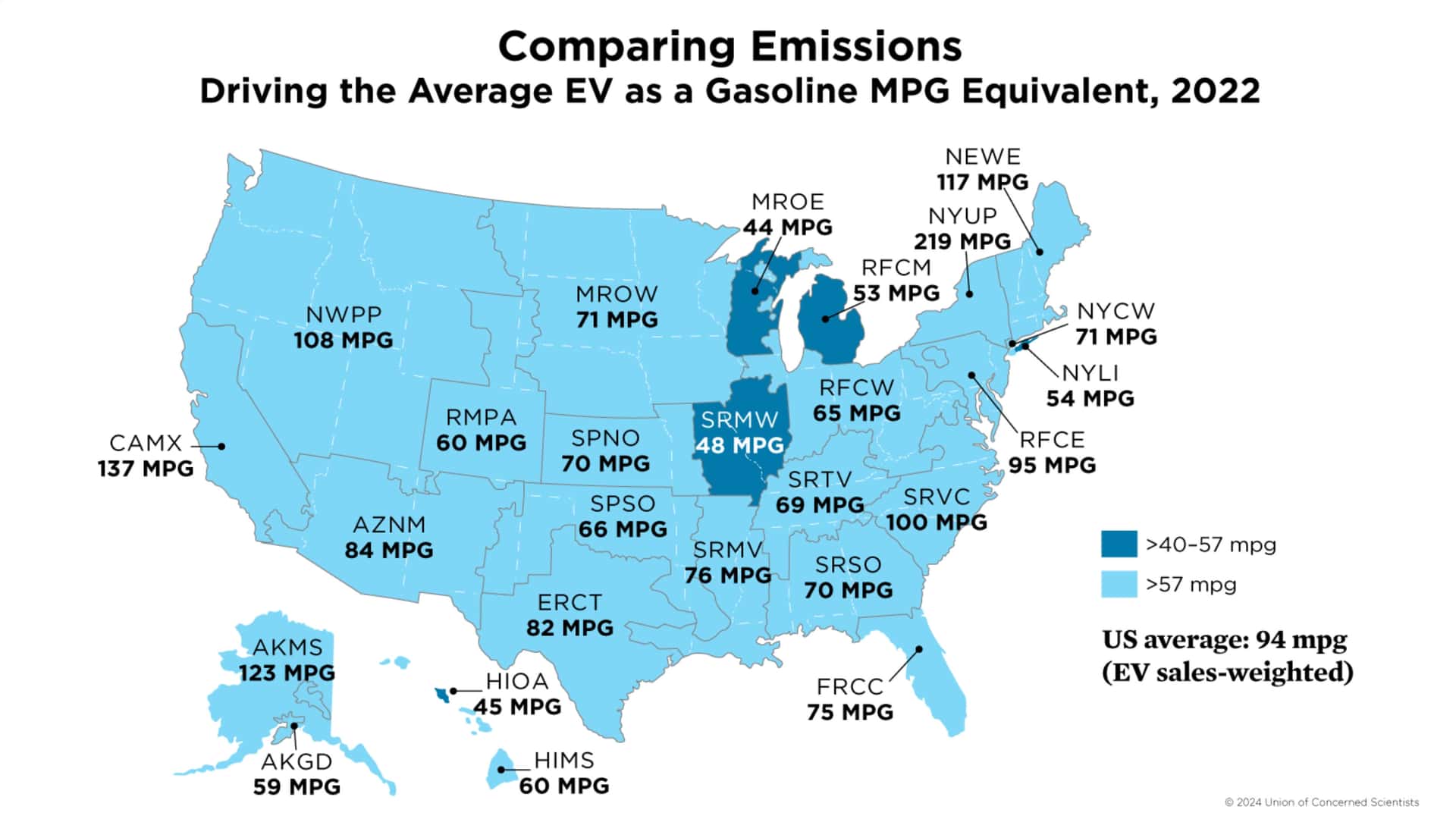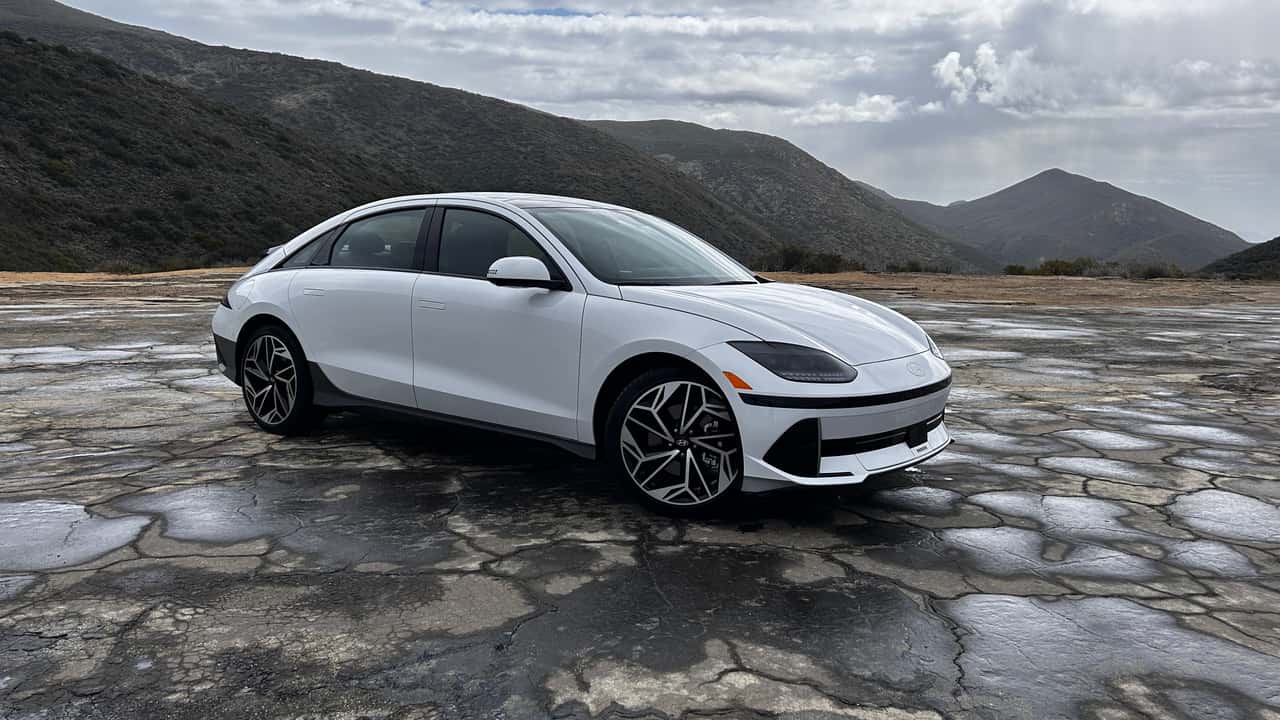Many variables determine the level of emissions resulting from driving an electric vehicle compared to an equivalent combustion engine car. A new study says that driving an EV will produce lower emissions in most parts of the United States—this was not the case over 10 years ago when the first study of this type was published.
The Union of Concerned Scientists (UCS) first published an analysis of the relative emissions of EVs driven in the US back in 2012 and their impact on the climate. It noted that less than half (45%) of Americans lived in regions where driving an EV instead of a gas car resulted in lower emissions than those produced by a very efficient combustion car capable of returning 50 mpg.
Get Fully Charged
If you live in upstate New York, driving EVs is way cleaner than ICE
While there are still areas of the US that heavily rely on coal or gas to produce electricity, charging your EV in those regions is not the cleanest, if you live in upstate New York or California, running an EV produces far fewer emissions than a comparable ICE vehicle.
Now, a new UCS study says the area where driving EVs produces fewer emissions than driving an efficient combustion car has expanded to include 93% of the entire US territory. They also changed the theoretical efficiency of the gas car they were comparing EVs against to 57 mpg, so the bar is even higher.
They note that “for the first time, we find that for everyone in the US, driving the most efficient EV produces less global warming emissions than any gasoline-only vehicle available (including non-plug-in hybrids).” Some areas have cleaner electricity than others, so, for instance, if you drive an average EV in upstate New York, which has America’s cleanest electricity production, it will be equal to a combustion car that does 219 mpg.
Gallery: Drivign EVs is Cleaner than ICE – UCS Study




Texas has more electricity produced by burning fossil fuels (over 60%), but even there, an EV is equivalent to a gas car that does 82 mpg. The UCS found that for the entire country, the average was a hypothetical 94 mpg. This could be improved further if all EVs were smaller and more efficient because there are plenty of electron guzzlers on the road these days that bring the average down—there is an acute lack of small, frugal and affordable EVs in the US.
How efficient the theoretical EV in question is has a big impact on a region’s efficiency rating. For instance, if instead of an “average EV” we choose a much more efficient car like the Hyundai Ioniq 6 or Lucid Air, then the equivalent efficiency of driving an EV in upstate New York rises to 285 mpg.
The UCS also compared the emissions of an average sedan with a combined efficiency rating of 32 mpg to an EV with a 300-mile battery and calculated the lifetime emissions to be 52% lower for cars and 57% lower for pickups. It also noted that driving an “average electric pickup” was cleaner than driving a 37-mpg hybrid truck, with an average nationwide rating of 61 mpg (142 mpg in upstate New York and 53 mpg in Texas).
It’s worth noting that when calculating the total environmental impact of an EV, we also need to factor in how the raw materials that went into its battery were gathered, where they were extracted from, and how far they traveled to the factory that processes them. This part of the EV supply chain is also responsible for considerable emissions and it often has a negative effect on the area where the materials originated from.
But if we’re referring strictly to the emissions produced to power these vehicles, driving EVs is considerably cleaner. The US has been cleaning up its electricity production, and by 2022, the proportion of energy generated from burning coal had dropped below 20%, while generation from renewable sources (like solar and hydroelectric) increased to 39%, according to the source UCS study.
Driving an Electric Vehicle (EV) in the U.S. is now one-third cleaner than a gasoline car, according to a recent study conducted by the Union of Concerned Scientists (UCS). This groundbreaking research highlights the environmental benefits of transitioning to electric transportation and underscores the urgent need for more widespread adoption of EVs.
The study compared the emissions associated with driving an EV versus a gasoline car in various regions across the country. It took into account the emissions generated from producing electricity for EVs as well as the emissions from extracting, refining, and transporting gasoline for traditional vehicles. The results were clear: driving an EV produces significantly fewer emissions than driving a gasoline car.
One of the key findings of the study is that the carbon intensity of electricity generation in the U.S. has been steadily decreasing over the past decade. This means that EVs are becoming cleaner to drive as the grid gets greener. In fact, in 2020, driving an EV produced an average of 60% fewer emissions than driving a gasoline car. And in regions with particularly clean electricity sources, such as California and the Northeast, the emissions reductions were even greater.
The benefits of driving an EV go beyond just reducing greenhouse gas emissions. EVs also help improve air quality by reducing harmful pollutants that are emitted from gasoline vehicles. This is especially important in urban areas where air pollution can have serious health consequences for residents. By driving an EV, individuals can play a direct role in improving air quality and public health in their communities.
Despite the clear environmental advantages of EVs, their adoption in the U.S. has been relatively slow. This is due to a variety of factors, including limited infrastructure for charging, range anxiety, and the higher upfront cost of EVs compared to gasoline cars. However, as technology continues to improve and the market for EVs expands, these barriers are becoming less significant.
Governments at both the state and federal levels are also taking steps to promote the adoption of EVs. In recent years, a number of states have implemented incentives for purchasing EVs, such as tax credits and rebates. And the federal government has announced plans to invest in expanding EV infrastructure and supporting the production of electric vehicles.
As the transportation sector continues to be a major source of greenhouse gas emissions in the U.S., transitioning to electric vehicles is crucial for reducing our carbon footprint and combating climate change. The UCS study provides further evidence that driving an EV is a cleaner and more sustainable alternative to driving a gasoline car. By making the switch to electric transportation, individuals can help build a more environmentally friendly future for generations to come.

